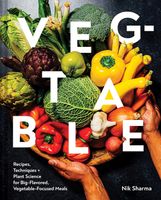Advertisement
Cooking Tips
Appears in
By Nik Sharma
Published 2023
- Lentils do not need soaking in water prior to cooking but they should be cleaned and rinsed.
- While fresh (and frozen) peas cook quickly, treat dried peas like beans and give them a soak prior to boiling (see Goan Pea Curry).
- Remove and trim the stem tops and any damaged ends from French beans and other green beans, as well as the thick string that runs along the seam of the bean. Blanch green beans in a pot of salted water for a few seconds until they turn bright green, then immediately plunge them into a bowl of ice water to prevent them from cooking further. Green beans can also be stir-fried, baked, roasted, or grilled.
- If green beans are overcooked, they will be tender but lose their intensity of color and turn dull. If you want to add them to pulao, stews, or braises, add them in the final 10 minutes of cooking.
- Beans can be cooked faster by removing their skins, presoaking, or boiling them in alkaline and monovalent solutions (read on for a description).
- I live in an area where the water is hard and contains a considerable amount of calcium and magnesium salts. Calcium and magnesium (called divalent salts—each element contains two exchangeable electrons) can enter the structural carbohydrate pectin molecule, making the seed stubbornly hard and take longer to cook. I use softened, deionized, or filtered water to cook beans. If that’s not an option, brine the beans, or boil them in water containing an excess amount of regular salt (sodium chloride) and baking soda (method follows). Monovalent ions (containing a single exchangeable ion) like those in sodium enter the pectin molecule, bumping out the calcium and magnesium and making the pectin softer and faster to cook.
- Pressure cooking beans is a lifesaver. The combination of high pressure and heat in the presence of water helps dried beans cook in a fraction of the usual time, anywhere between 15 and 30 minutes. I still like to soak beans prior to pressure cooking because this helps awaken the enzymes and kick off various plant biochemical pathways that help beans become easier to cook and digest.
- Beans are notoriously associated with flatulence. We lack the enzyme alpha-galactosidase to break down certain galactose-containing sugars—like raffinose, stachyose, and verbascose—in beans. Our gut bacteria ferment these sugars, which results in bloating and flatulence. Soaking beans in water or brining them helps reduce the occurrence of flatulence by removing these sugars through the action of enzymes present in the beans. Some of those sugars are released into the soaking water, so it should be discarded and fresh water used for cooking. Just a heads-up: None of these methods is 100 percent effective; because all beans are created differently and contain varying amounts of these sugars, they respond differently to these methods. In South Indian cooking, spices like ground fenugreek seeds are added to fermented dosa and idli batters made from rice and legumes; the yeast and bacteria, combined with the fenugreek, help with digestion of these sugars. As always, a candle can be lit—or try Beano and Gas-X (this section is not sponsored by them).
- Kombu or kelp contains alpha-galactosidase, an enzyme that digests raffinose and is used in preparing beans to reduce flatulence. The enzyme works best at an acidic pH and at 140°F [60°C]; it loses its efficacy at temperatures above 176°F [80°C], so adding kombu to boiling water will not be very useful. I soak two 6 in [15 cm] sheets of kombu in 4½ cups [1 L] water at 140°F [60°C], add 1 tsp [6 g] fine sea salt and 1 tsp [5 ml] fresh lemon juice, and maintain the temperature overnight using a sous vide device. If you don’t own a sous vide device, an Instant Pot will work: Set it at the warm setting, which ranges from 145°F to 172°F [63°C to 78°C] as per the manual. You can also replace the kombu with a Beano pill, which also contains the enzyme alpha-galactosidase.
- To save time during the week, I cook beans and lentils, drain, and freeze in ziptop bags for up to a month.
- Jícama, like cucumber, releases a lot of water when tossed with ingredients like salt, sugar, and dressings or vinaigrettes. Add it to a salad just before it’s ready to be served or eaten.
- Lectins are another hot topic that comes up with beans and cereals like wheat. Lectins are a type of protein found in beans that can bind carbohydrates. Lectins in their native state can bind proteins and are a very useful scientific tool when trying to study blood types; however, this ability to bind carbs can cause health issues by affecting nutrient absorption and a host of other gut-related issues. Foods high in lectins are rarely consumed raw; we don’t eat beans raw, and properly hydrating beans by soaking and cooking them significantly destroys the lectins. Removing the seed hull and sprouting beans is another way to reduce the amount of lectin. However, slow-cooking beans by simmering at a very low temperature isn’t the most effective way to get rid of all the lectins; the better option is to presoak the beans and cook them at a higher temperature. In short, cook your beans well, and don’t eat them raw or undercooked.
- Some peas, like raw sugar snap peas, might feel a bit tough; blanching (30 seconds) or steaming (1 minute) followed by stir-frying will help make them tender.
- A word on canned and precooked (steam-packaged) lentils and beans: If it makes cooking easier, use them. If you want to soak and cook your beans from scratch, do it. The only person who needs to have a say in this is you.

